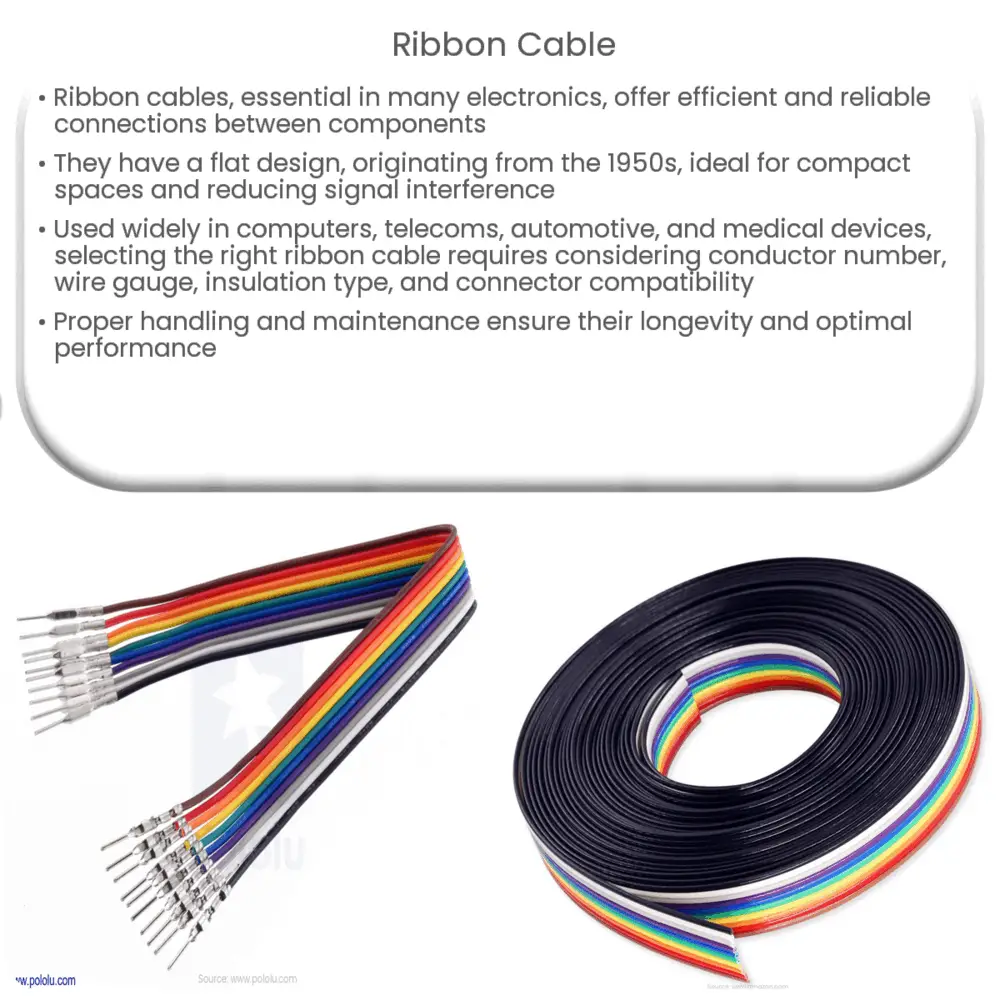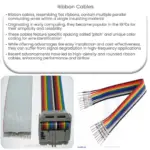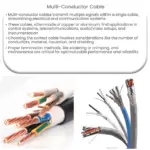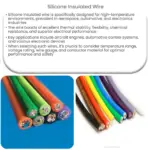A ribbon cable is a flat, flexible multi-wire cable used to connect electronic components in devices, offering efficient routing and easy installation.

Ribbon Cable: The Essential Guide
Introduction
Ribbon cables are an essential component in many electronic devices, providing reliable and efficient connections between different components. In this article, we will explore the history of ribbon cables, their various applications, and the benefits they offer. We will also discuss how to choose the right ribbon cable for your needs and provide tips for proper handling and maintenance.
What is a Ribbon Cable?
A ribbon cable, also known as a flat or multi-wire planar cable, is a type of cable that consists of multiple parallel wires attached to one another with a thin layer of insulating material. The wires are typically color-coded to facilitate identification and are arranged in a flat, flexible, and organized manner. This design allows for efficient routing and easy installation in tight spaces, making ribbon cables ideal for connecting components within electronic devices.
History of Ribbon Cables
The development of ribbon cables can be traced back to the 1950s, when engineers at companies like IBM and 3M began experimenting with flat conductors to create compact, reliable connections for computer systems. In 1961, 3M introduced the first commercially available ribbon cable, the “Scotchflex” cable, which quickly gained popularity in the burgeoning computer industry. Over the following decades, ribbon cables evolved to accommodate the growing needs of various electronic devices, and today they are an indispensable part of many modern technologies.
Applications of Ribbon Cable
Ribbon cables are used in a wide range of applications, from consumer electronics to industrial equipment. Some common uses include:
- Computers: Ribbon cables have long been used to connect internal components of computers, such as hard drives, optical drives, and motherboards.
- Telecommunications: In telecommunication systems, ribbon cables are often employed to connect switches, routers, and other network equipment.
- Automotive: Ribbon cables are used in modern vehicles for connecting sensors, control units, and other electronic components within the vehicle’s infrastructure.
- Medical Devices: Ribbon cables are often found in medical devices, such as diagnostic equipment and patient monitoring systems, due to their reliability and compact form factor.
Benefits of Ribbon Cables
There are several key advantages to using ribbon cables in electronic devices, such as:
- Space Efficiency: Ribbon cables have a flat, low-profile design that allows them to be easily routed in tight spaces, making them ideal for use in compact devices.
- Reduced Signal Crosstalk: The parallel arrangement of wires in ribbon cables helps to minimize signal interference between adjacent wires, improving overall signal quality and reliability.
- Ease of Installation: Ribbon cables are typically color-coded and pre-terminated with connectors, simplifying the installation process and reducing the risk of errors.
- Flexibility: The flexibility of ribbon cables enables them to be easily bent and manipulated, allowing for custom routing and installation in a variety of applications.
Choosing the Right Ribbon Cable
When selecting a ribbon cable for your project, there are several factors to consider:
- Number of Conductors: Determine the number of wires required for your application, as ribbon cables are available with varying numbers of conductors.
- Wire Gauge: Consider the wire gauge (thickness) that will best suit your needs, as this can affect the cable’s current-carrying capacity and flexibility.
- Insulation Material: Different insulation materials offer varying levels of durability, flexibility, and temperature resistance, so choose one that is appropriate for your specific application.
- Connector Type: Ensure that the ribbon cable is compatible with the connectors used in your project. Common connector types include IDC (Insulation Displacement Connector), D-subminiature, and Molex connectors.
Tips for Handling and Maintenance
To prolong the life of your ribbon cables and ensure optimal performance, follow these guidelines:
- Proper Handling: Be gentle when handling ribbon cables to avoid damaging the wires or insulation. Do not pull on the cables or bend them excessively, as this can cause the conductors to break or the insulation to crack.
- Storage: Store ribbon cables in a cool, dry environment away from direct sunlight and excessive heat or humidity. Coiling the cables loosely and securing them with a cable tie can help prevent tangling and damage during storage.
- Regular Inspection: Periodically inspect your ribbon cables for signs of wear, such as frayed wires or damaged insulation. Replace any damaged cables promptly to prevent potential issues in your system.
- Cable Management: Use cable management techniques, such as cable ties or cable channels, to keep your ribbon cables organized and protected from potential damage due to movement or contact with other components.
Conclusion
Ribbon cables are a versatile and reliable solution for connecting components in a variety of electronic devices. By understanding their history, applications, and benefits, as well as how to choose the right cable for your needs and properly maintain it, you can ensure the longevity and performance of your ribbon cable connections. With their space-saving design, reduced signal crosstalk, ease of installation, and flexibility, ribbon cables continue to be a popular choice for many industries and applications.




